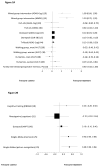Treatment for mild cognitive impairment: systematic review
- PMID: 24085737
- PMCID: PMC3943830
- DOI: 10.1192/bjp.bp.113.127811
Treatment for mild cognitive impairment: systematic review
Erratum in
- Br J Psychiatry. 2014 Jan;204(1):81
Abstract
Background: More people are presenting with mild cognitive impairment (MCI), frequently a precursor to dementia, but we do not know how to reduce deterioration.
Aims: To systematically review randomised controlled trials (RCTs) evaluating the effects of any intervention for MCI on cognitive, neuropsychiatric, functional, global outcomes, life quality or incident dementia.
Method: We reviewed 41 studies fitting predetermined criteria, assessed validity using a checklist, calculated standardised outcomes and prioritised primary outcome findings in placebo-controlled studies.
Results: The strongest evidence was that cholinesterase inhibitors did not reduce incident dementia. Cognition improved in single trials of: a heterogeneous psychological group intervention over 6 months; piribedil, a dopamine agonist over 3 months; and donepezil over 48 weeks. Nicotine improved attention over 6 months. There was equivocal evidence that Huannao Yicong improved cognition and social functioning.
Conclusions: There was no replicated evidence that any intervention was effective. Cholinesterase inhibitors and rofecoxib are ineffective in preventing dementia. Further good-quality RCTs are needed and preliminary evidence suggests these should include trials of psychological group interventions and piribedil.
Conflict of interest statement
All other authors report no conflicts of interest.
Declarations of interest: CL has received grant support (research or CME) from NIMH, NIA, Associated Jewish Federation of Baltimore, Weinberg Foundation, Forest, Glaxo-Smith-Kline, Eisai, Pfizer, Astra-Zeneca, Lilly, Ortho-McNeil, Bristol-Myers, Novartis, National Football League, Elan, Functional Neuromodulation Inc.; he has been a Consultant/Advisor to Astra-Zeneca, Glaxo-Smith Kline, Eisai, Novartis, Forest, Supernus, Adlyfe, Takeda, Wyeth, Lundbeck, Merz, Lilly, Pfizer, Genentech, Elan, NFL Players Association, NFL Benefits Office, Avanir, Zinfandel, BMS; and received Honorarium or travel support from Pfizer, Forest, Glaxo-Smith Kline, Health Monitor.
Figures



Comment in
-
ACP Journal Club. Review: Cholinesterase inhibitors do not prevent dementia in patients with mild cognitive impairment.Ann Intern Med. 2014 Apr 15;160(8):JC11. doi: 10.7326/0003-4819-160-8-201404150-02011. Ann Intern Med. 2014. PMID: 24733216 No abstract available.
References
-
- Petersen RC. Mild cognitive impairment as a diagnostic entity. J Intern Med. 2004;256(3):183–194. - PubMed
-
- Lopez OL, Kuller LH, Becker JT, Dulberg C, Sweet RA, Gach HM, et al. Incidence of dementia in mild cognitive impairment in the cardiovascular health study cognition study. Arch Neurol. 2007;64(3):416–420. - PubMed
-
- Tschanz JT, Welsh-Bohmer KA, Lyketsos CG, Corcoran C, Green RC, Hayden K, et al. Conversion to dementia from mild cognitive disorder - The Cache County Study. Neurology. 2006;67(2):229–234. - PubMed
-
- National Institute for Clinical Excellence (NICE) Dementia CG42. 2006.
-
- Jorm AF, Korten AE, Henderson AS. The Prevalence of Dementia - A Quantitative Integration of the Literature. Acta Psychiatrica Scandinavica. 1987;76(5):465–479. - PubMed
Publication types
MeSH terms
Substances
Grants and funding
LinkOut - more resources
Full Text Sources
Other Literature Sources
Medical

